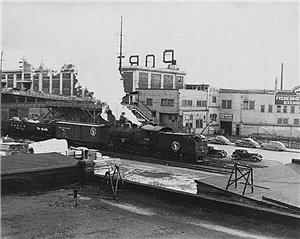Piers 64, 65, and 66, including the Bell Street Pier and the Bell Harbor complex, are located south of Virginia Street and east of Belltown. The area was once a shantytown, home to mostly Native Americans. The steep drop-off allowed docks to be built parallel to the shore. These included the Orient Dock, replaced by the Lenora Street Piers (64 and 65) for the "Princess Ships" of the Canadian Pacific Railroad, and finally, the Port of Seattle's original Pier 66 (built in 1914 on dirt dumped from the regrade of Denny Hill). The modern-day piers connect to Belltown via a pedestrian bridge.
From Canoe Races to Cruise Ships
Development came late to the waterfront north of Virginia Street, and the area sprouted a shoreline shantytown. This was cleared in 1903 as work began on the Denny Regrade and expansion of shoreline railroad services.
The area's steeper drop-off allowed construction of docks parallel to the shoreline. The largest of these was the Orient Dock, which was later replaced by the Lenora Street Piers (64 and 65) for the "Princess Ships" of the Canadian Pacific Railroad and the Leslie Salt Co. A bridge linked the pier to Belltown on the east (since recreated as a pedestrian elevator and overpass).
During the first Denny Regrade (1903-1911), a giant flume conveyed upland soil to Elliott Bay at the foot of Bell Street. In 1914, the Port of Seattle built its original Pier 66 headquarters atop the drowned dome of former Denny Hill.
Piers 64, 65, and 66 were reconstructed in the mid-1990s to create the Bell Street Pier and Bell Harbor complex, including a marina, cruise ship terminal, conference center, Odyssey Maritime Discovery Center, restaurants, and marine services. The project connects with the upland World Trade Center, parking, hotels, and Belltown via a modern version of the original Bell Street bridge.
To go to Part 10, click "Next Feature"
Sources:
Clarence B. Bagley, History of Seattle (Chicago: S.J. Clarke Publishing Co., 1916) and History of King County (Chicago: S. J. Clarke Publishing Co., 1929); Richard C. Berner, Seattle in the 20th Century, Vols. 1, 2 & 3 (Seattle: Charles Press, 1991, 1992 & 1999); Padraic Burke, et al., Pioneers and Partnerships: A History of the Port of Seattle (Seattle: Port of Seattle, 1995); Walt Crowley, National Trust Guide: Seattle (New York: Preservation Press, 1998); Paul Dorpat, Seattle Now & Then, Vols. I, II & III (Seattle: Tartu Press, 1984, 1988 & 1989); Edmond S. Meany, History of the State of Washington (New York: MacMillan Company, Publishers, 1950); Murray Morgan, Skid Road (New York: Viking, 1951); David J. Olson, et al., Port in a Storm: An Historical Review of the Founding of the Port of Seattle (Seattle: Port of Seattle, 1970); Roger Sale, Seattle: Past & Present (Seattle: University of Washington Press, 1976); James R. Warren, King County and its Queen City: Seattle (Woodland Hills, CA: Windsor Publications, Inc., 1981).
Licensing: This essay is licensed under a Creative Commons license that
encourages reproduction with attribution. Credit should be given to both
HistoryLink.org and to the author, and sources must be included with any
reproduction. Click the icon for more info. Please note that this
Creative Commons license applies to text only, and not to images. For
more information regarding individual photos or images, please contact
the source noted in the image credit.

Major Support for HistoryLink.org Provided
By:
The State of Washington | Patsy Bullitt Collins
| Paul G. Allen Family Foundation | Museum Of History & Industry
| 4Culture (King County Lodging Tax Revenue) | City of Seattle
| City of Bellevue | City of Tacoma | King County | The Peach
Foundation | Microsoft Corporation, Other Public and Private
Sponsors and Visitors Like You

